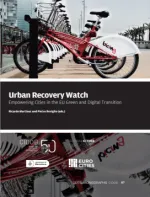The Spanish recovery strategy, an urban paradox.The case of Barcelona

The Spanish Recovery, Transformation and Resilience Plan is built upon an urban paradox. As stated in previous research led by CIDOB, some of the pivotal priorities addressed in the €163bn1 strategy developed by the Spanish government are linked to local competences and urban challenges. Yet local governments have not been invited to take part in the design of the plan nor in its monitoring and evaluation. Despite its urban dimension, they are mere beneficiaries of an unprecedented budget that is somewhat accelerating a recentralisation trend.
The 31 components that make up the ten lever policies laid out in the Spanish recovery plan show a strong commitment to boost reforms and investments in which city governments and urban stakeholders should play a major role. Table 1 provides evidence of that.
According to the Spanish Federation of Municipalities and Provinces (FEMP), in the period 2021-2023 more than €18bn has been made available for local governments by both the central government and autonomous communities. This accounts for more than 20% of the total non-refundable funds available.
Up to 13 Spanish government ministries are engaging with local governments to implement initiatives within the various priorities included in the Spanish plan. Yet almost 70% of the funds made available have been managed by two ministries: the Ministry for Ecological Transition and the Demographic Challenge (€6.07bn) and the Ministry of Transport, Mobility and Urban Agenda (€6.54bn). This seems to tie in with the type of competences devolved to local governments in the Spanish legislation.